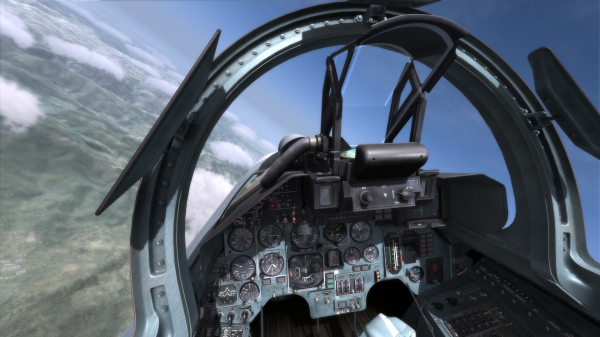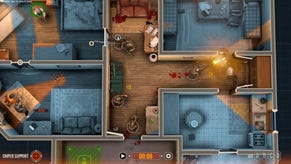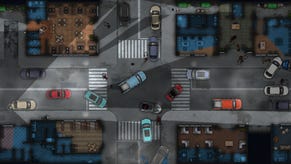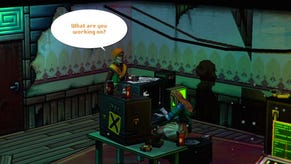The Flare Path: Broach And Clear
Simulation & wargame news
Thanks to a pair of heavily patched barrage balloons and an antique ex-Latvian Army Bofors gun, yesterday passed uneventfully in the Flare Path household. Using the derelict abattoir across the valley as cover, Cupid tried one pop-up attack, but a flurry of 40mm fury quickly sent him packing. “The little rascal really needs to work on his tactics” I thought to myself as, back at my desk, I perused correspondence from Eagle Dynamics' Matt Wagner and KillHouse Games' Dan Dimitrescu. “Either that or trade-in those arrows for Brimstones.”
Kicking Doors And Taking Notes
As I mentioned last week, three Silent Hunter shapers tired of simulating sweaty stealth-heavy combat and gloomy, claustrophobic interiors, have recently broken away from Ubisoft Romania and started work on a game about sweaty-stealth heavy combat and gloomy, claustrophobic interiors. Projectiles in the encouragingly Rainbow Sixy Door Kickers travel a tad faster than SH's electric eels but it looks like good timing and carefully plotted approach routes will be every bit as important for CT choreographers as they were for U-boat kapitäns
After designer Dan Dimitrescu had outlined some basics (DK will be pauseable real-time, feature a range of authentic room-clearing tactics and weaponry, and come with a mission editor, mission generator, and an iron-man campaign in which friendly losses drain a finite personnel pool) he tackled a few specific questions.
RPS: Assuming hostages are present in some missions, are you intending to model mis-identification?
Dan: Regarding the hostages, yes, they're in, and we're also considering more freeform scenarios such as active shooter - where civilians are present but not directly controlled by the bad guys.
At the moment mis-identification is not modeled. We're considering it, but its not a simple nut to crack and its part of the same package as less than lethal options, arrests, bad guys surrendering (or faking it) and the lot.
The way our game is currently played is you direct your troopers mainly via paths and when needed cones of fire, but you do not tell them to shoot / not shoot, and there's no question on who to shoot at the moment as they'll automatically engage bad guys. Now thinking out loud if an unknown would be encountered the player would have limited info at his disposal due to the top down perspective, so he'll have to look at animations & gestures or trust his troopers. Going on this line of thought, the player will decide to have someone cover or check / subdue the unknown, thus limiting his forces available for other tasks or overall security.
I think I like it :)
RPS: How detailed is the ballistics simulation likely to be? Might we, for instance, see rounds travelling through thin internal walls/organs?
Dan: We're looking to have a measure of statistical terminal ballistics modeled in in that there will be various possible results to each bullet hit, function of bullet type, impact velocity and body part hit. Armor will also play a factor here but I'm mostly concerned about bad guys armor as we really don't want the player to take chances based on his armor. The game will be quite unforgiving - leave your back exposed and the armor will rarely save you.
Overpenetration of walls and objects is under consideration at the moment. Overpenetration on humans will most likely be in, but we need to add some specific AI routines related to it - shoot / no shoot decisions they will take based on danger to target background.
Also to me it goes without saying that external ballistics will be in - bullets will lose velocity from the moment they are fired as they travel through space, and this can result in less body armor penetration or less stopping power as per the statistical tables I was talking about above. Once you'll be able to customize the troopers weaponry this will make quite a difference when choosing for example an ultra-short CQB friendly 5.56 carbine vs a regular 14.5" M4. The M4 will present more problems when negotiating tight spaces, but will push the 5.56 at velocities that guarantee proper fragmentation at any range that you are likely to meet in our game.
However, just to be clear, none of the above will be in the initial alpha! We are focusing on the basic gameplay elements now and this one is pretty advanced.
RPS: Does the top-down perspective mean scenarios featuring multi-storey buildings are out?
Dan: No way :) While the current version is limited - flat levels and buildings that fit in one screen only - we will change that pretty soon. Multi-storeys are essential but of course present a problem when people on different storeys should be able to see each other. We have a visual solution in mind but we'll have to experiment a little bit. That is, after initial alpha release.
RPS: Booby traps and suicide belts now seem to be part of a CT squad's lot. Will Door Kickers players have to worry about such things?
Dan: Suicide bomber type of enemies are on the "to do" list. Booby traps are farther down the list and will require some testing to see if the available feedback is enough or if its ok to just get the feedback from a trooper that he can't proceed because of a trap.
RPS: Have you had any input from serving or retired counter-terrorist personnel?
I am good friends with a highly trained serving member of a local CT unit and yes, we are in contact for this purpose. Also he has more than once run me and other guys through various drills related to CT work. Couple with research, books and other not so local sources I'd say we have a pretty strong basis to work from.
RPS: Thanks for your time
Eyrie Realism
Eagle Dynamics are being especially dynamic at the moment. In addition to overseeing the development of a flock of third-party DCS World projects, they're toiling away on a new graphics engine, and preparing study sims of the F-15, F-18, Su-27 and Fw 190. I thought it was about time I caught up with them.
RPS: The range of upcoming DCS World add-ons is pretty diverse. Are you open to any suggestions from third-party plane builders?
Matt Wagner: With the exception of a few aircraft that we are reserving to be developed internally or by one of our close partners, licensed third parties are free to develop any aircraft they wish. These are currently ranging from World War 2 era aircraft to the modern day. We now have an SDK available for licensed third party partners that will speed up and ease the process. We will also be providing tools to licensed partners for new map development.
RPS: Sales-wise, which modules have proved the most popular so far?
Matt: Most all modules have met our sales expectations, and this includes both the extremely detailed DCS series like A-10C, Black Shark, and P-51D and the more shallow learning curve titles like Flaming Cliffs 3. We realize that not all potential customers want to spend weeks studying to fly an aircraft, so we think it important to provide a range of products that appeal to more than one type of flight simulation enthusiast.
RPS: Combined Arms invites comparisons with Steel Beasts, Combat Mission: Shock Force, and Arma. Do you think it will ever be capable of going toe-to-toe with any of these titles?
Matt: Combined Arms is primarily designed as a companion to DCS World and other modules. Particularly from the Command Map, it allows players to direct the ground battle from the cockpit. This is of course far different from what you will find in ArmA and SB. We do also provide the ability to take first person control of most armed ground units, but these are modeled at a very shallow learning curve to allow users to jump in easily. Where we see the CA series have the most value is in multiplayer though. Even with the current beta, you can have CA users in large multiplayer games commanding ground forces and designating ground targets for ground attack, as other players occupy DCS aircraft.
RPS: The Nevada terrain seems to have been in the pipeline for ages. What's the story there?
The original effort was done by a third party, but for various reasons, that effort did not work out and the Eagle team basically had to re-start it from scratch. Much of the Nevada map is now done, but aspects of it could certainly change between now and release. Due to the massive number of ground objects, elevation mesh detail, and texture sizes, a new image generator (IG) had to be created in order to run it at more than single digit frame rates. We call this new IG the Eagle Dynamics Graphics Engine (EDGE). Creating EDGE has been a huge undertaking and it takes a lot of time. More so than anything else, this has been the reason behind the delay.
RPS: ED sims are an important part of the virtual air show scene. Any plans to enhance facilities for virtual aerobatic teams and their fans?
Matt: The most important improvement we are working on now to support this is a more robust new work environment that is much more stable.
RPS: The Fighter Collection isn't a typical videogame publisher. For those that might not have heard of them before, can you explain who they are and how they got involved with ED?
Matt: In the early 1990s, The Fighter Collection (TFC) was looking for CAD/CAM software to assist in aircraft renovation of their collection of vintage aircraft at Duxford Airfield. In this process, they learned about a Russian software developer called Eagle Dynamics. TFC bought into Eagle Dynamics and shortly thereafter the team also created a flight simulation of the Su-27 Flanker . The simulation was shown to Jim Mackonochie of Mindscape/SSI, and this later went on to become the game Su-27 Flanker, and was the first in a longer series of products from TFC/Eagle Dynamics.
RPS: Do you believe aircraft manufacturers have the moral right to demand license fees from sim developers?
Matt: If the U.S. Government has funded (tax payer money) the development of an aircraft, then in my opinion, the manufacturer has no moral rights.
RPS: Which came first for you, an interest in gaming or an interest in aviation?
Matt: Probably both at the same time. Even when as young as around 12 years old (early 1980s), I was already heavily into early flight simulation games. I also received my pilot's license at 16 years old with plans to enter one of the military academies to pursue that life. However, due to a sports injury in high school, I am now content to be a virtual fighter pilot.
RPS: What's the most gratifying aspect of your job as a producer?
Matt: Any time you spend months or even years helping to create and manage a product to completion and then see both great user and critical response, that is probably the most satisfying. It makes all the work worthwhile to see the work appreciated and bring enjoyment to others.
RPS: Thanks for your time
The Flare Path Foxer
According to The Times, last week's foxer was solved by Inspector Lestrade of Scotland Yard. Those of us that were there know that phlebas, Mr. and Mrs. skink74, and mrpier actually did most of the sleuthing.
“Boulton Paul Overstrand – Strand Magazine
Mil Mi-4 “Hound” – Hound of the Baskervilles
Beechcraft Bonanza – The Case of the Copper Beeches
Lockheed Hudson – Mrs Hudson, Holmes’ landlady
Fairey Delta 2, tested at Boscombe Down – The Boscombe Valley Mystery
Baker rifle – 221b Baker Street
The Maiwand Lion in Forbury Gardens Reading, commemorating the Battle of Maiwand, where Dr Watson was wounded.”
Two clues were misread (the plane with the pointy proboscis was a BAC 221 - a later incarnation of the Fairey Delta - and the pic of the V-tailed Bonanza in Paris was meant to be a reference to Robert Moriarty's Eiffel Tower stunt, but the misreadings were so ingenious the Foxer Adjudication Panel chose to let them pass.
This week's puzzle is a centennial tribute to the ill-fated Hughes-Bagwell Expedition. On 15th February 1913, a team of Lost World enthusiasts led by Queen Victoria's cousin, naturalist Gertrude Hughes-Bagwell, left London for Melanesia aboard the converted whaling ship, Improbable.
The dinosaur hunters never reached their destination, but let's assume they did. You're Edward Nye, the expedition's Farman floatplane pilot. It's your job to scout the pictured island for tree-top Archaeopteryx roosts. Time is of the essence (there are hundreds more isles waiting to be explored) so its vital you visit every jungle hex and return to your start location as quickly as possible.
Every sea or jungle hex entered adds 1 minute to your flight time. Every hill hex (there's no need to survey these) adds 2 minutes. Red crosses mark impassable peaks (No entry!). The feeble Farman's lack of manoeuvrability means sharp turns are impossible. Only the three hexes in your forward arc are viable destinations. Straying over the map edge isn't permitted.
A Flare Path flair point made from a Giant Moa gastrolith to the plotter of the quickest route.





















